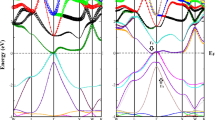Abstract
A decrease in the resonance frequency of plasma oscillations of free carriers ωp, observed in p-type Bi2 – xSbx (0 < x < 2) crystals with increasing temperature, can only partially be explained by an increase in the crystal-polarization background ε∞. An analysis of experimental data suggests that the temperature change in ωp observed in the range from 80 to 300 K is also due to a decrease in the ratio of the concentration of free carriers to their effective mass p/m*. This can be explained by an increase in the carrier effective mass with increasing temperature, as well as by the process of hole redistribution between nonequivalent valence-band extrema, whose existence is confirmed by the regularities of temperature changes in the width of the optical band gap, observed in the infrared reflection spectra.





Similar content being viewed by others
REFERENCES
B. M. Gol’tsman, V. A. Kudinov, and I. A. Smirnov, Thermoelectric Semiconductor Materials Based on Bi2Te3 (Nauka, Moscow, 1972) [in Russian].
L. D. Ivanova and Yu. V. Granatkina, Inorg. Mater. 36, 672 (2000).
S. A. Nemov, N. M. Blagikh, and L. D. Ivanova, Phys. Solid State 56, 1754 (2014).
N. P. Stepanov, V. Yu. Nalivkin, and V. A. Komarov, Izv. RGPU Gertsena 157, 74 (2013).
V. A. Kul’bachinskii, A. Yu. Kaminskii, and V. G. Kytin, J. Exp. Theor. Phys. 90, 1081 (2000).
N. P. Stepanov and A. A. Kalashnikov, Opt. Spectrosc. 129 (2021, in press).
L. R. Testardi, J. N. Bierly, and F. J. Danahoe, J. Phys. Chem. Sol. 23, 1209 (1962).
C. H. Champness and A. L. Kipling, J. Phys. Chem. Sol. 27, 1409 (1966).
V. A. Kutasov, B. Ya. Moizhes, and I. A. Smirnov, Sov. Phys. Solid State 7, 854 (1965).
J. H. Dennis, PhD Thesis (Massachusetts Inst. Technol., Cambridge, MA, 1961).
V. A. Kulbachinskii, V. G. Kytin, P. M. Tarasov, and N. A. Yuzeeva, Phys. Solid State 52, 1830 (2010).
Author information
Authors and Affiliations
Corresponding author
Ethics declarations
The authors declare that they have no conflict of interest.
Additional information
Translated by A. Kazantsev
Rights and permissions
About this article
Cite this article
Stepanov, N.P., Kalashnikov, A.A. & Uryupin, O.N. Band Structure and Processes in the Electronic System of (Bi2 – xSbx)Te3 (0 < x < 2) Crystals, According to Optical Studies in the Infrared Range. Semiconductors 55, 637–641 (2021). https://doi.org/10.1134/S1063782621070186
Received:
Revised:
Accepted:
Published:
Issue Date:
DOI: https://doi.org/10.1134/S1063782621070186




